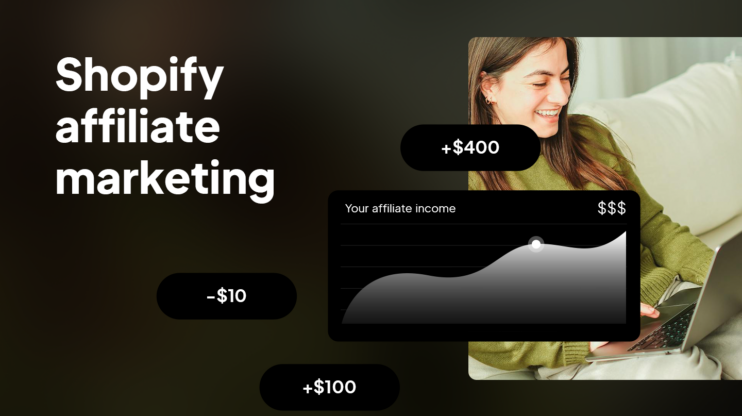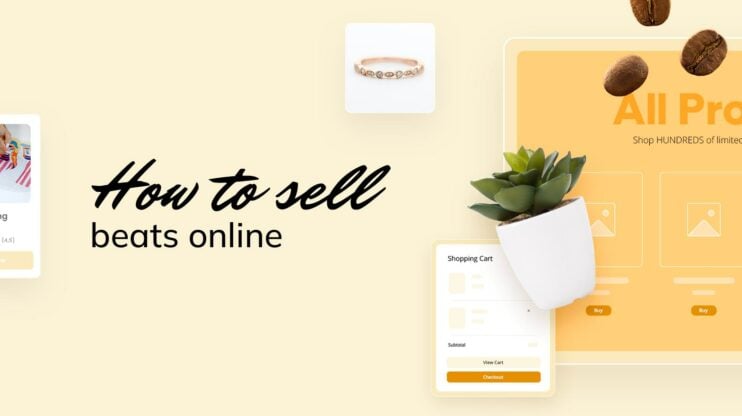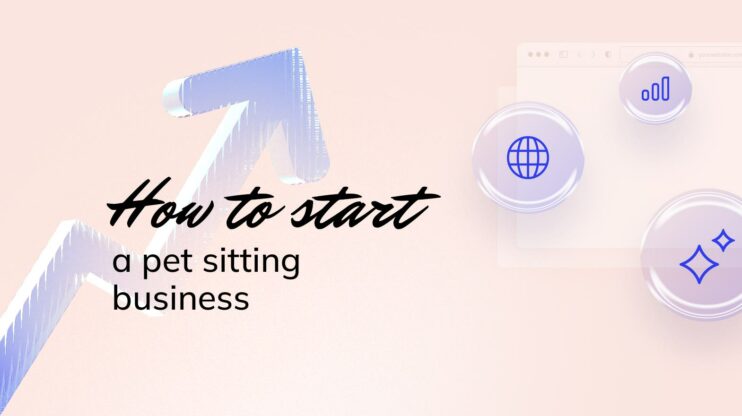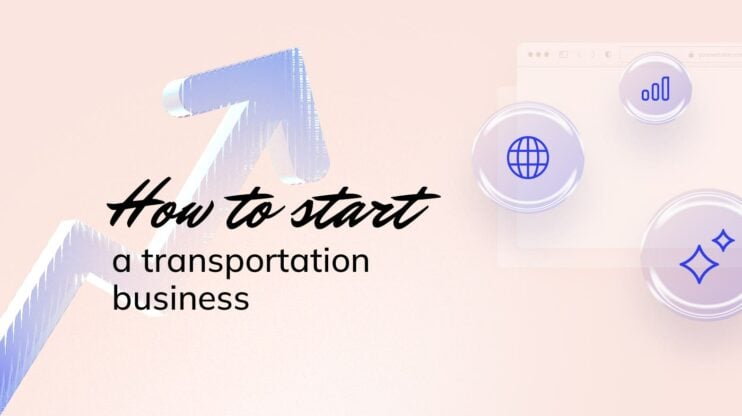If you’ve ever thought about selling products online, whether handmade candles, digital templates, or even dropshipped pet gear, there’s never been a better time than now. Ecommerce is booming. And with some help from AI tools, you don’t need to be a tech genius or spend months building a fancy website to get in on this deal.
With the right tools, you can launch a fully functional store in days, not weeks. All it takes is a clear idea, a few smart steps, and a platform that makes the heavy lifting feel light.
If you want to learn how to create a website for selling products, we have some interesting wares for you. Get help with everything from choosing a domain name and scoping out products to designing pages that sell and bring in real traffic (not just your mom and best friend).
And if you want to skip the hard part? Tools like 10Web’s AI Website Builder can help you generate a professional store in minutes, automatically handling your design, structure, and even content.
But first, you must get to know your audience, walk a mile in their shoes, and get inside their collective head. Once you know your audience, you’ll have a guiding star for choosing your domain name and starting a website to sell products.

Create your online store in minutes!
Looking to sell online? Develop and launch your store with 10Web AI Ecommerce Website Builder.
Step 1: Before you build a website to sell products
Before you get into ecommerce platforms, logos, or layouts, take a step back and ask yourself: Who is this for, and why would they buy it? The clearer your answer, the easier it becomes to create a website for selling products.
Define your audience as if you know them personally
Start with the basics: age, location, job, interests, and income. But don’t stop there. Think about what’s going on in their life that makes your product the perfect fit. Are they:
- Busy parents looking for simple solutions?
- Side hustlers looking to save time?
- Gen Z shoppers who care about sustainability or aesthetics?
The more specific you get, the easier it is to choose the right photos, words, and offers for your website.
Pro tip: When you feel like you’re writing for one person instead of the whole internet, your site instantly feels more human and persuasive.
Pressure-test your product
Even great ideas need validation. Before investing too much time starting a website to sell products, make sure people actually want what you’re selling.
- Search for similar products on Etsy, Amazon, or Google Shopping. Are people buying?
- Check Reddit or niche Facebook groups. Are there conversations or complaints your product solves?
- Use tools like Google Trends or AnswerThePublic to see what people are searching for.
You’re on the right track if your product solves a real problem or taps into a real desire. Bonus points if it’s a recurring need or requires repeat purchases.
Analyze the competition (without getting intimidated)
Don’t be afraid to peek at what others are doing. Look at the top 3–5 websites selling something similar and ask:
- What are they doing well (design, pricing, descriptions)?
- Where do they fall short?
- How can you stand out?
Even minor tweaks, like better product photos, faster shipping, or a more relatable brand voice, can help you carve out your place.
Want to test the waters with zero inventory? Create a dropshipping website in minutes and sell trending products without upfront costs.
Step 2: Choose a domain and hosting plan that works from day one
Any website’s foundation consists of its domain name (your web address) and hosting (the service that keeps your site live and speedy). Without these, even the best products in the world won’t reach your customers.
Your domain name = your online street address
This is the name people type into their browser to find you, like cozycandles.com or plantshop.com. It’s often your brand name, but it can also reflect your niche or product category.
Tips for choosing a great domain name:
- Keep it short and memorable.
- Avoid dashes, numbers, or hard-to-spell words.
- Stick with .com if possible. It’s still the gold standard.
- Check availability before you fall in love.
And yes, you can change your domain later, but it’s best to get it right from the start. Don’t hem yourself in if you want to create a website for selling products. You may decide to expand or focus on a smaller market in the future. Choose a flexible domain that can grow and evolve with your business.
Hosting: what it is and why it matters
Web hosting is what makes your website show up when someone clicks your link. High-quality web hosting is essential for an inviting virtual storefront. If your site is slow, people tend to leave within seconds.
When comparing hosting providers, look for:
- Fast loading speeds
- Good uptime (you want your site to be online 24/7)
- SSL security (shows your site is safe — this matters for trust and SEO)
- Built-in backups and support
Fortunately, managed hosting takes the sting out of the technical side of websites. For example, with 10Web’s WordPress Site Builder, hosting is built-in, secure, fast, and optimized from day one. With an all-in-one platform like this, you create, manage, and maintain your site from one dashboard.
Step 3: Map out the pages your store really needs
To create a website to sell products, you need a clear, simple plan. Think of it like a store layout: people should know where they are, what to click next, and how to buy.
Creating a solid site structure helps your visitors feel at home and helps search engines understand and rank your pages better. Start with the homepage, then create the main landing pages.
Homepage: the storefront window
This is where most people land, so it should:
- Show what you sell immediately (no guesswork).
- Highlight your bestsellers or collections.
- Include a clear call to action (“Shop Now,” “Browse Products,” etc.).
- Have clean visuals, fast load times, and easy navigation.
If you’re not sure where to start, 10Web’s AI Website Builder can generate a homepage tailored to your niche and product type. There’s no need to stare at a blank page. Just tell the AI how you want the site to look.
About page: build trust in seconds
People buy from people. Use this page to:
- Share your story and what makes your brand different.
- Include a photo if you’re the face of the brand.
- Mention how your product is made or why it solves a real problem.
It’s best to keep things friendly and personable. Remember when you walked a mile in your hypothetical customer’s shoes? Now is a great time to share your observations and experiences that connect you to your audience.
Contact page
Even if most buyers won’t need it, having a contact page signals legitimacy. Include:
- A simple form or email address.
- Social media links.
- Shipping info, return policy, or FAQs if not already covered elsewhere.
Make this page easy to find in your top menu or footer.
Product pages
You’ll build these out in detail later, but it helps to plan ahead:
- One page per product or product category.
- Use clean layouts with great photos and concise descriptions.
- Always include price, availability, and a clear “Add to Cart” button.
Think: “What would I want to know before buying this?”
Blogging your way to more sales
A blog isn’t required, but it can boost your SEO, drive traffic, and build trust. For example, a post like “5 Best Candles for Relaxing at Home” can lead readers straight to your product listings. Building your main pages and polishing your product pages should be a priority if you’re just starting, but planning a blog as a later addition to your site can be a valuable investment.
Step 4: Use AI to create a website for selling products
This is the part that usually trips people up: designing the actual site. But with 10Web, you don’t need to stare at a blank screen or drag blocks around for hours. It’s the easiest way to build a website. The AI takes care of layout, branding, copy, and structure. You just guide it.
What makes a good website design?
AI takes out much of the guesswork, but what matters most for good website design?
- Consistent branding (colors, logo, fonts)
- Clear navigation (so people don’t get lost)
- Mobile optimization (half your visitors will be on their phone)
- Strong call-to-actions (so people know what to do next)
And with the right tool, these best practices come built-in.
How to build a website to sell products with 10Web AI (step by step)
- Go to the 10Web AI Website Builder
- Describe your business:
- What kind of business are you building? (“I sell handmade soap” or “I dropship pet products”)
- What are your goals? (sell online, collect emails, promote services)
- Select and edit pages and page sections – Drag and drop to reorder, add, or remove page sections.
- Choose a visual style – Pick the color and theme direction you like: modern, minimal, colorful, etc.
- Let the AI generate your website – It will create a homepage, about page, contact page, and even product pages with starter content and structure tailored to your business.
- Customize with the AI-powered 10Web editor – Use the drag-and-drop builder to:
- Edit text, swap images, or tweak layouts.
- Add or remove sections with zero coding.
- Preview everything on mobile and desktop before going live.
- Add your products – Use the built-in ecommerce tools to:
- Upload product photos and descriptions
- Set pricing, categories, and stock
- Connect payment methods like Stripe, PayPal, Apple Pay, or Google Pay
- Generate a logo instantly – Don’t have branding yet? Use the free 10Web Logo Maker to create a professional-looking logo in minutes.
- Pick your style, enter your brand name, and get design variations ready to use.
- Click “Publish” and you’re live – Your site goes live with built-in hosting, SEO features, and a mobile-ready layout from day one.

Create your online store in minutes!
Looking to sell online? Develop and launch your store with 10Web AI Ecommerce Website Builder.
Bonus design tips to keep in mind
Even with AI doing the heavy lifting, a guiding hand goes a long way.
- Use real product images: clear, well-lit photos convert better than any placeholder.
- Make buttons obvious: “Shop Now,” “Add to Cart,” and “Buy Today” should stand out.
- Keep fonts and colors consistent: build trust and visual flow.
- Think mobile-first: test how your site looks and works on a phone.
Step 5: Set up products, payments, and shipping
Once you build a website to sell products, it’s time to add what really matters: your products. Whether you’re selling digital downloads, handmade goods, or drop-shipped items, this is where you turn your website into a store.
The good news is that with 10Web, you don’t need to install plugins or figure out complex ecommerce tools. Your online store runs on WooCommerce, the most trusted ecommerce platform for WordPress, already optimized and integrated into your 10Web dashboard.
Add your first products
Here’s how to start filling your virtual shelves:
- Go to your 10Web dashboard → Ecommerce→ Products → Add New
- Fill in the key info:
- Product name
- Price
- Short description (what it is + why it’s great)
- Full description (materials, size, details, care instructions, etc.)
- Upload high-quality photos from different angles
- Pro tip: Clean backgrounds and natural lighting make a big difference.
- Organize products into categories (like “Skincare,” “Best Sellers,” or “New Arrivals”)
You can also mark items as digital/downloadable, set inventory limits, and manage stock levels, all in one place.
Set up payment methods
One of the most powerful things about 10Web’s ecommerce integration is how easy it is to accept payments securely and globally.
In your 10Web dashboard under Ecommerce → Payment Methods, you can enable:
- Credit & debit cards
- Google Pay / Apple Pay
- Cash on delivery
- Check payments
- Direct bank transfer
All of these can be managed through your site’s 10Web dashboard. No third-party gateways or manual coding is required. In addition, WooCommerce extensions and WordPress plugins also allow you to set up a variety of payment methods, including Buy Now, Pay Later (BNPL) services and options for cryptocurrencies.
Set up shipping like a pro
Whether you’re shipping handmade jewelry or drop-shipped gadgets, WooCommerce gives you flexible control over shipping:
- Choose your shipping zones (local, national, international)
- Set flat rates or real-time carrier rates (USPS, FedEx, etc.)
- Offer free shipping thresholds (e.g., “Free shipping over $50”)
- Decide if you’ll charge by weight, item count, or order value
Need help calculating rates and finding the best shipping method? A good delivery management tool that works directly with WooCommerce should be your first stop.
Don’t forget the “thank you” page
After checkout, your customer lands on a “thank you” page. This is a powerful moment, use it to:
- Confirm their order and set expectations on what happens next
- Offer a discount on their next purchase
- Encourage them to follow you on social media
- Ask them to share their purchase or sign up for your newsletter
10Web’s built-in editor lets you customize this page just like any of the site’s other pages or sections.
Step 6: Attract buyers with SEO
So you’ve managed to create a website for selling products and your store looks amazing. But you won’t make sales if no one can find it. That’s where search engine optimization (SEO) comes in.
SEO helps your site appear in Google search results when someone looks up products like yours. And the best part? You don’t need to be an SEO expert to get started. You just need the right tools and a few smart habits.
Keyword research
Keywords are the words and phrases your ideal customer types into Google. Start by identifying what your audience might be searching for, like:
- “best organic soaps for dry skin”
- “custom planner stickers for teachers”
- “eco-friendly candles under $20”
Social media and sites like Google Trends or Keyword Planner will help get started on research.
Once you have a few relevant phrases, use them on relevant pages. Make sure the page’s content is clear to visitors and search engines by including it in:
- Product titles and descriptions
- Page headlines (H1, H2)
- Image alt text
- Meta descriptions
Don’t overdo it, keep it readable and helpful. Think clarity, not keyword stuffing.
Optimize pages
The 10Web platform (powered by WordPress) gives you access to powerful SEO plugins like Yoast SEO or All in One SEO, so you can:
- Set custom page titles and meta descriptions
- Create clean, keyword-rich URLs
- Add schema markup (which can help with rich snippets in Google)
- Preview how your pages look in search
Bonus: If you’re using the 10Web AI Website Builder, many of these settings are pre-optimized. Just tweak them for the page.
Build authority
Off-page SEO means building credibility by getting other sites to link to yours. Here’s how to get started:
- Ask bloggers or influencers to review your product
- List your store in online directories or forums
- Guest post on relevant blogs in your niche
- Use social media to drive shares and mentions
Even a few quality links can give your store a major SEO boost.
Local SEO (if it applies)
You can go with creating a website to sell products, but what if you have a local audience? If you sell to locals (like homemade products or services in your city), be sure your website includes:
- Your city/region in page titles and descriptions
- Local delivery or pickup options
- “Near me” keywords (for example, “gift baskets near Pasadena”)
If you have a physical location or service area, create a Google Business Profile for increased search visibility and to keep your customers up to date on the latest details.
Track what’s working and what’s not
Once you’ve got traffic coming in, monitor your performance using:
- 10Web’s built-in analytics dashboard
- Google Analytics (track visitors, bounce rate, conversions)
- Google Search Console (see what keywords you’re ranking for)
This helps you refine your product descriptions, blog posts, or layouts based on real results, not guesswork. It’s one thing to create a website for selling products. You have to take a certain amount of risk in projecting customer appetite. Take advantage of the website’s data. You can learn a lot about user behavior and improve the overall user experience…and conversions.
Step 7: Start getting visitors and sales with smart marketing
Your website for selling products is live. You’re ready to ship. Now what?
It’s time to get traffic. Not just random visitors but the right people who want what you’re selling. You don’t need to go viral or spend thousands on ads. When you’re starting a website to sell products, a few focused marketing strategies are enough to get the ball rolling.
Show up where your audience hangs out (social media)
You don’t have to be everywhere, just where your ideal buyers tend to hang out.
- Instagram: Great for visual products like fashion, candles, or accessories. Use Reels, carousels, and Stories to show off your brand.
- Pinterest: Perfect for DIY, home goods, and lifestyle products. Create pins that link back to your product or blog pages.
- TikTok: If you’re comfortable on camera, even quick behind-the-scenes clips can boost visibility.
- Facebook Groups: Join niche communities and share helpful content (not just promo posts).
Pro tip: If you’re making a website to sell products, add your website link to every profile bio, post a mix of engaging content with the occasional promo displaying a clear CTA (e.g. “Shop Now”). And don’t forget to tag your products when possible.
Start an email list (it’s not just for big brands)
Email is still one of the highest-converting marketing channels. Even if you only have 5 people on your list, start now. That way, when you’re ready to run promotions or launch a new product, you already have a warm audience.
What to send:
- A welcome email when someone subscribes
- Behind-the-scenes updates
- Product tips or how-to guides
- Early access to new launches or discounts
10Web integrates with popular email tools (like Mailchimp or MailPoet), so setting this up is quick and seamless.
Collect and show off customer reviews
Social proof builds trust fast. Ask buyers to leave a review after checkout or send a friendly follow-up email. Even a simple “Loved it!” says a lot to prospective buyers.
Display reviews:
- On product pages
- On your homepage or in a testimonial section
- In your emails or social media posts
Bonus: WooCommerce makes collecting and moderating reviews easy, and 10Web keeps everything in one place.
Try influencer, affiliate, or content marketing
Once you’re ready to grow, these strategies can bring in new traffic steadily:
Influencer and affiliate marketing – Work with small creators or content partners who love your niche and know the audience.
Content that converts – Use blog posts to bring in long-term organic traffic. If you created a blog, now’s a great time to add helpful content, like guides, product comparisons, or tutorials.
Affiliate marketing – Let others promote your products in exchange for a commission.
Step 8: Maintain your store with minimal effort
Starting a website to sell products is a big win, but staying on top of it doesn’t have to feel like a full-time job. With a little routine maintenance, you can keep everything running efficiently, improve performance over time, and focus on growing your business, not fixing broken buttons.
Here’s what to check regularly to keep your site in great shape:
Keep product info up to date
Every few weeks, scan through your product pages:
- Update descriptions if anything changes (ingredients, sizing, bundles, etc.)
- Add fresh product photos if older ones look outdated or inconsistent
- Remove or hide sold-out items, or mark them clearly as “Out of Stock”
- Keep pricing consistent across platforms (your store, Etsy, social, etc.)
Little updates keep your site feeling active and trustworthy.
Stay on top of inventory, orders, and performance
WooCommerce (built into your 10Web dashboard) helps you track your inventory and manage orders. From here, you can view and manage:
- Inventory levels
- Order statuses
- Shipping confirmations
- Customer notes
Set low stock alerts so you never oversell, and keep a spreadsheet or dashboard view to plan restocks easily.
Check for bugs, broken links, or slowdowns
Every few weeks (or after major edits) do a quick scan:
- Test buttons, forms, and checkout on desktop and mobile.
- Click every major menu and footer link to check for 404 errors.
- Use Google PageSpeed Insights to spot any performance issues..
- Back up your site regularly, 10Web does this for you automatically
Track your traffic and sales over time
Log in to your:
- 10Web dashboard for quick performance insights
- Google Analytics to track where visitors are coming from
- WooCommerce Reports to see which products are top sellers
This data helps you decide what to promote, where to invest time, and what to cut.
Keep your plugins and software up to date
The 10Web platform handles core updates, but it’s always smart to:
- Review installed plugins every month (especially if using WooCommerce add-ons)
- Deactivate any unused ones
- Apply updates promptly (they often patch bugs or security issues)
Set a monthly site checkup routine
- Check for outdated product listings
- Review site speed on mobile
- Update featured collections or homepage banners
- Clear spam comments or abandoned carts
- Review SEO performance (keywords, rankings, click-throughs)
Ready to create a website for selling products? 10Web makes it faster and easier
Online shopping is expected to hit over $6.5 trillion in global sales by 2026. That’s a whole lot of opportunities, and people are still discovering new stores every day. Whether you’re selling handmade goods, curated products, or something totally unique, you don’t need to go big right out of the gate. You just need to get going.
With an AI website maker like 10Web, you don’t have to juggle multiple tools, hire a developer, or spend weeks figuring out how to connect all the pieces. It’s built to simplify every step:
- AI-generated site structure, design, and content (in minutes)
- Built-in WooCommerce ecommerce engine
- One dashboard to manage products, payments, and shipping.
- Automatic mobile optimization, hosting, backups, and speed tuning
- Free logo maker to make your brand look professional from day one
So, instead of wasting time piecing everything together, you can focus on what really matters: growing your business and making sales. Ecommerce is only getting bigger, why not start now?

Create your online store in minutes!
Looking to sell online? Develop and launch your store with 10Web AI Ecommerce Website Builder.
FAQ
Can I make my own website to sell products?
Yes, and it’s easier than you might think. You don’t need to be a designer or hire a developer. With options and tools like 10Web’s AI Website Builder, you can create a professional, ready-to-sell online store in just a few steps. AI handles your design and layout, so you just add your products, connect payments, and go live. It’s fast, affordable, and perfect for beginners.
How much does it cost to build a website to sell products?
Costs can vary, but today’s tools make launching your store very affordable. Many all-in-one platforms (like 10Web) offer plans that include hosting, ecommerce features, and AI design starting at just a few dollars a month. You’ll also need a domain name (usually around $10–20/year). You can build a great-looking online store for much less than hiring a web designer or developer.
How do I create a website to sell things for free?
You can start with website builders offering free trials or basic free plans. For example, 10Web offers a free trial where you can generate your ecommerce site, design it, and even add products. Sites like Ecwid and Square that provide options to sell products online for free often suffer from drawbacks, like limits on how many products you can sell before you need a paid plan. Open-source software like WooCommerce or OpenCart is free to use, but you’ll need to set things up yourself on the web hosting of your choice.
How do I make my own products to sell online?
It depends on what you want to sell, but there are lots of great options. You can handmake products (like jewelry or candles), use print-on-demand services to create custom designs, source items to resell, or create digital products (like templates or ebooks). Start by thinking about your skills, passions, or a gap you’ve noticed in the market, then test and refine based on what customers respond to.














